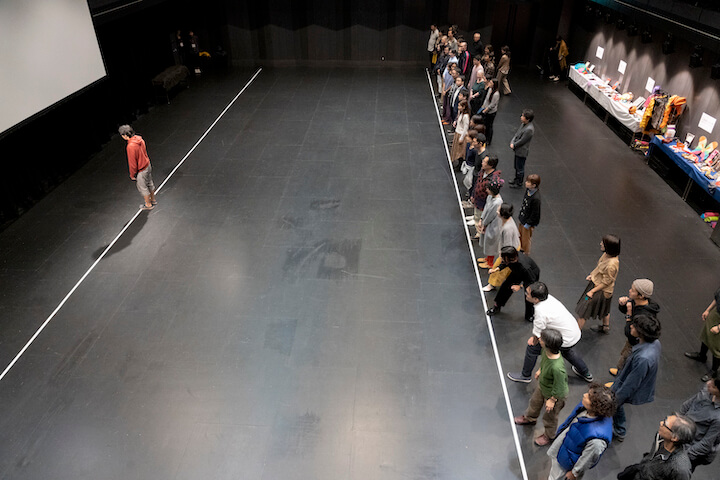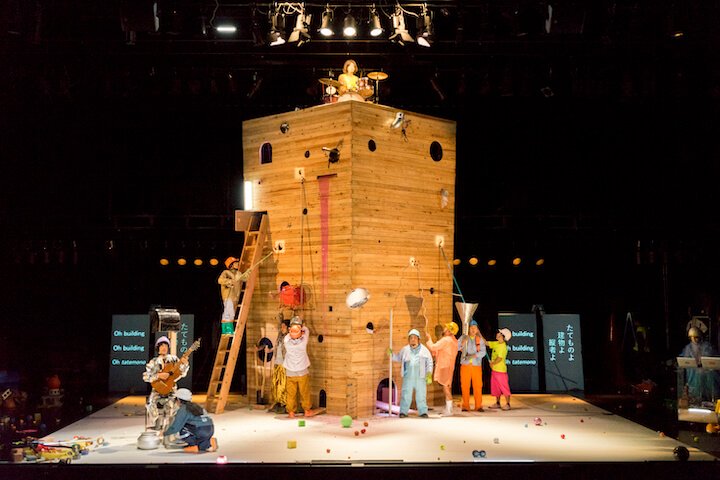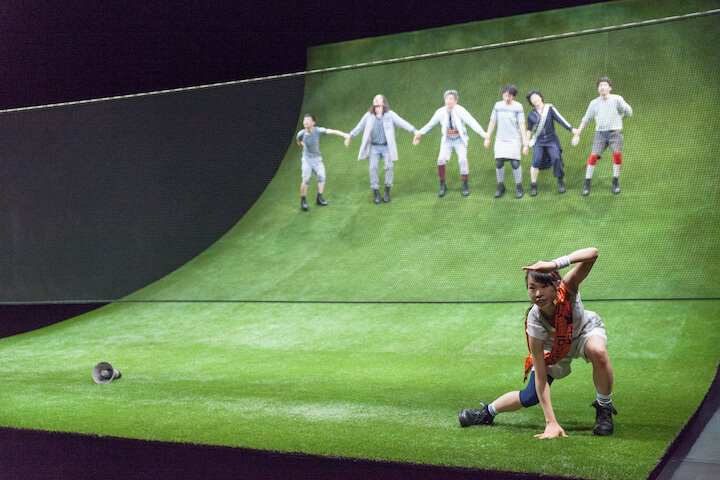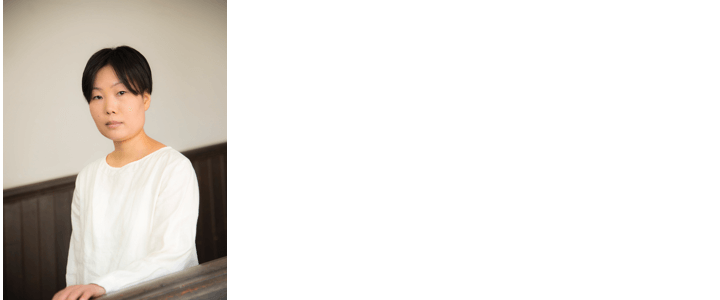magazine
The History of Collaborations at Kyoto Experiment and an Outlook on the Future of the Festival / Megumi Takashima
2021.3.9

Kyoto Experiment (KEX), under the direction of three new co-directors, positions collaborations between artists from different fields of expressions as part of the program’s structure. The first part of this essay is based on an interview with the three directors, on their reasons and intentions, and their outlook on the future of the festival. The second half reviews, as a guide, the past collaborations during the ten years under Yusuke Hashimoto’s direction.
The intention behind collaborations
On the intention behind Shows (performance program), as well as re-questioning the various borders concerning the performing arts such as the audience and stage, subject of performance, and gender, Yoko Kawasaki says “how we overcome, disassemble and update the border of genre, which we unconsciously define, with the collaborations is also important”. By collaborating with artists from a different field, it may lead to questioning habits and customs, the discovery of new perspectives and axes of thought, and the horizon of a new expression. “By collaborating with an artist from a different genre, it becomes necessary to do something new. It’s the same with the three of us in this shared directorship, we recognize things that we wouldn’t have on our own, and our way of thinking also changes” says Juliet Reiko Knapp.
Yuya Tsukahara says “It’s going to become more important to present work from Kansai. In previous international festivals, it was mainstream to introduce topical works from the West. Of course, there is value in being able to see the latest works, and I’ve also been influenced by this, but from a director‛s perspective, it becomes mundane doing the same thing, and the times are changing. To create an original festival, means that something is born from that festival”.
 Teppei Kaneujitower (THEATER), 2017, photo by Yuki Moriya
Teppei Kaneujitower (THEATER), 2017, photo by Yuki Moriya
The two collaborations in Shows
In this edition, The Otoasobi Project and Ayaka Nakama, both from Kansai, will be taking on the collaboration element.
First, The Otoasobi Project and Seiko Ito meet for the first time. The Otoasobi Project based in Kobe has a diverse composition of members; those with intellectual disabilities and those without, experimental musicians, and music therapists. Their collaborator Seiko Ito is an artist and creator, as well as being a pioneer of the Japanese hip hop scene. In their collaboration, as well as the difference in genre between music vs. theatre and text, and improvised music vs. hip hop, “there is also a difference in the local and cultural background between the slow conceptualism of the Kansai music scene, and the hip hop and assertive style of Tokyo. How will these differences come into effect in the collaboration?”, anticipates Tsukahara.
Next, Ayaka Nakama & Choreography‛s Freeway Dance which premiered in 2019 at Kobe’s DANCE BOX, will be recreated into a Kyoto version. The reason this piece was selected was its experimental collaborative aspect that resists staying within the framework of a solo dance piece. Its performance time is a total of four hours, with time to eat incorporated and the audience free to enter and exit as they like. The performance space itself is designed like a garden with no boundary between audience and stage. The movement which Nakama performs is based on the ‘memory of dancing for the first time’, given to her by people who are not specialists of dance or choreography;
the selected memories of others are mixed inside Nakama’s body and replayed. Her costume changes, the action of asking the audience to help her pour water into an improvised river to wash the costume, Bon odori and clapping, gymnastics – actions far from dance are all treated equally. Along with doubts towards the autonomous perfection of choreography, the privileged body of the dancer, and the intensity of the spectacle, boundaries such as the performance time with a clear start and end, choreography and ordinary actions, the subject of a movement, self/other, to watch/be watched, are ambiguously mixed together. Kawasaki also points out “as well as the concept of the performance and choreography, staff including lighting and sound technicians and the gardener in charge of the scenography participate as collaborators; it is interesting to see the quiet revolt against the existing production system where there is usually one director who holds all the authority standing at the top of a hierarchy”.
Tsukahara also notes that the performance was born because of the location of DANCE BOX in Shin-Nagata. In Shin-Nagata there are communities of Koreans, migrants from Amami and immigrants from South-East Asia such as Vietnam; each have classes and clubs for their folk-dancing and arts, and DANCE BOX’s contemporary dance is classified as the same as one of these in the local area. These viewpoints that treat dance as something relative, may be one of the reasons that encouraged conversations and collaborations with non-specialists of dance.
How will the festival present its originality and characteristics alongside the local culture, and not become the kind of festival that simply circulates topical work that can be seen all over the world? We anticipate that KEX will provide stimulation and nourishment to the participating artists, as well as energizing the performing arts scene in Kansai and strengthening its creative foundation, along with its future development.
 Chiten, Sports Play (2016 SPRING) Photo by Takuya Matsumi
Chiten, Sports Play (2016 SPRING) Photo by Takuya Matsumi
The history of collaborations during the past ten years of KEX
Since its first edition in 2010, KEX has been proactively including collaborations into its program. In AGATHA – The Limits of Dance / The Limits of Words (2010), a text recital by a French literature professor and theatre director, and the physical expression of the dancers co-existed and competed on the stage. VARIABLES (2011) by visual and performance unit Kyupi Kyupi, mixed together a powerfully entertaining direction with Rokyoku (a kind of traditional sung-narrative), Nihon buyo (traditional Japanese dance) and taiko by female performers. Thikwa + Junkan Project (2012) presented a collaboration between two groups from Japan and Germany composed of artists with/without disabilities, and presented a thrilling physical conversation transcending the contexts and borders of disability and non-disabled, welfare and art, Japan and Germany. In Sports Play (2016 Spring) by Chiten and composer Masahiro Miwa, following their collaboration in Kein Licht. (2012), the audience became opponents facing a fictional competition space that emerged on the stage. The chorus in the booths upstairs performed, playing the role of the stadium audience. Nationalism, sports as an alternative to war, the desire for spectacle and criticism towards theatre, provocatively involved the audience, and unfolded with a greatintensity.
In Tomomi Adachi and contact Gonzo’s Teslan Run (2016 Spring), contact Gonzo performed under a Tesla coil generator to a performance by voice performer and composer Tomomi Adachi using a visual score made in a workshop with children. By going back and forth between rules and improvisation, lighthearted playfulness and serious intensity, various phases of the body and sounds were made subjective through electronic amplification. music for percussion (2017) by Ryoji Ikeda and Eklekto, was a concert composed for Swiss percussion ensemble Eklekto by Ryoji Ikeda, known for using electronic sounds outside the audible range, and high-speed, high-density visual media to challenge the critical point of the human audio-visual experience. Along with the acoustic yet electronic music-like auditory experience, the act of playing as mathematically regulated, input to output, approaches issues of choreography. In Teppei Kaneuji’s tower (THEATER) (2017), actions by a diverse cast including actress Izumi Aoyagi, a text by Toshiki Okada, a performance by contact Gonzo, and musician Shinji Wada took place around the construction, tower, that materialized Kaneuji’s sculptures and visual art on stage. The performance developed and extended Kaneuji’s consistent method of collecting and collaging, to a three-dimensional theatrical space, as well as to the raw body, and a time axis.
Natsuko Tezuka / Floating Bottle Floating Bottle Project vol.2 Dive into the point (2018) was an ambitious experiment that strategically incorporated the active participation of the audience into the performance, as well as being a collaboration between artists from different locations and cultures. Floating Bottle is a unit established by the dancer and choreographer Natsuko Tezuka, with Venuri Perera from Sri Lanka and Yeong Ran Suh from South Korea. In this performance, the audience are made to participate in a team competition, and what starts as a game of Statues undergoes repeated orders and rule changes. The audience experience a ‘rational social system’ where individuals are under complete management and control for the ultimate goal of efficient operation of corporations and organizations. Though participants are given the freedom of stepping down from this game=competition, it is reinforced that the framework of the performance itself cannot be altered, and with the construction of the overall system, entrusting the executions of authority such as giving orders and directing to the team leader, selected from the participants on mutual agreement, is held worthy of criticism for being a concealment of the authority of choreography and direction. Although the time for sitting in a circle to discuss thoughts after the game was the core of this performance, in exposing the self-recognition of the audience towards the irrationality of the system of competition and management because of its rationality, there was not enough time to reach the essential debate. Management related rules regarding the performance length, theatre closing times, and smooth operation of the festival showed the fundamental limits of this performance. If the artist and participants continued the discussion until satisfied, by exiting the theatre and moving to a café or on the streets to continue the debate (a peaceful measure), or occupying the theatre because the performance ‘has not yet finished’ (a more extreme measure), dance would cease to be a safe product shown at the theatre, and transform into something with the radical power for revolution
for change.
Collaborations between artists of different genres is of course part of the festival’s operative strategy, with reasons such as topicality, novelty, the extra value of world premieres, and developing new audiences. However, the true value lies in leading to the future creativity of the artist, contributing to the energy of the scene, and the visualization, sharing and deepening of the understandings of potential issues (for the audience too). When different expressive fields, and historical, geographical, cultural, and lingual contexts meet with the individual human body as the smallest unit, to converse and bring awareness to issues and put them under multilateral inspection, the festival and performing arts can be truly ‘public‛. Of course, collaborations between first meetings will inevitably become a ‘new production’, and contrary to expectations, there is a risk because the outcome is uncertain. Despite this, we hope that the mentality of ‘experiment’ is pursued, without fearing the risks.
This essay includes partial overlapping and reformatting from the following review:

Megumi Takashima
Art and performing arts critic. Researcher of Kyoto University of Arts Archival Research Center. Currently contributes reviews to the web magazine artscape. Co-publications include Journey of the physical sensation -Régine Chopinot and PACIFIKMELTINGPOT (Osaka University Press, 2017).
 Check these out too!
Check these out too!
The Otoasobi Project & Seiko Ito OTO KYO-OTO OTTOTTO SEIKO-OTO (Day 1 AGARU / Day 2 SAGARU)
Ayaka Nakama & Choreography Freeway Dance
#collab #kansai
















